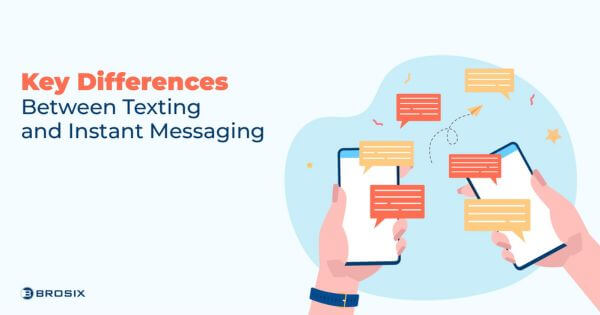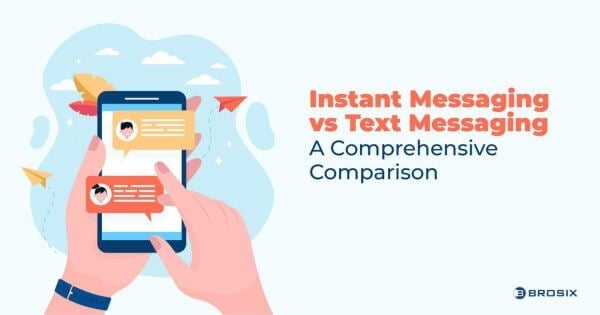Texting has become an integral part of almost everyone’s life, whether it’s for personal or professional reasons. The term texting itself is often used as a synonym for messaging.
The truth, however, is that texting refers to so-called text messaging, which is about sending short messages over a cellular phone. The other popular option that we have is instant messaging (IM). These are two completely different services, although they have a common root, common goals, and common characteristics.
So, today’s topic is instant messaging vs text messaging. Let’s embark on an enlightening journey about the differences and similarities between these two methods of interacting. Equipped with the necessary information, you can easily make informed choices about your personal and business communication.
What Is Text Messaging?
Text messaging, or texting, refers to sending and receiving short electronic messages between two or more mobile devices. It requires a cell phone number and an active cellular network connection. Texting comes in two forms: a short message service (SMS) and a multimedia messaging service (MMS).
SMS is widely used as a marketing tool by a variety of companies. In such cases, text messaging requires written consent from the recipient.
What Is Instant Messaging?
Instant messaging, or IM, is the process of sending real-time messages through software applications. Instant messaging applications can be downloaded or accessed online. Most of them are available for both desktop and mobile use. However, instant messaging apps can’t work without an internet connection.
Popular examples of instant messaging tools for personal use include Facebook Messenger, WhatsApp, and Viber. On the other hand, businesses use enterprise messaging apps, such as Signal, Slack, WeChat, and Brosix.
Instant messaging is no longer associated with sending texts only. IM software offers a set of features that enhance synchronous communication. Some of the most prominent ones are data backups and high-level privacy and security. Most of the personal and business instant messaging apps also allow users to make video and voice calls and share files with a few clicks.
What Is the Main Difference Between Instant Messaging and Text Messaging?
The main difference between instant messaging and text messaging lies in their platform and connectivity requirements. Instant messaging requires internet access and operates through third-party over-the-top (OTT) apps—web-based and/or downloadable. On the other hand, text messages—SMS and MMS—are transmitted between mobile devices through built-in apps. To send short messages, you need a phone number and network coverage.
Text messaging is mostly suitable for time-sensitive alerts and appointment reminders, while instant messaging offers unlimited global texting, rich media support, and advanced functionalities.
Key Differences Between Texting and Instant Messaging

In this section, I have compared the differences between texting and messaging in terms of 17 parameters. Take a look:
| Feature | Text messaging (SMS) | Instant messaging (IM) |
| Device compatibility | Any cell phone | Any device with an option for internet (smartphone, laptop, computer, tablet, etc.) |
| Network | Cellular network required | Internet connection required |
| Software | Native texting app | Downloadable apps and/or web apps |
| Carrier independence | No | Yes |
| International messaging | Carrier-dependent | Internet-based |
| Bulk messaging | Yes | No |
| Content support | SMS, MMS (text, photos, videos) | Wide range of content (text, images, videos, voice messages) |
| Cost | May involve additional fees | Usually free after app download; data charges may apply |
| Character limit | 160 characters for SMS and 1,600 characters and up to 10 images for MMS | Unlimited (WhatsApp is an exception, with a limit of up to 65,536 characters) |
| Functionality | Basic text and multimedia | Advanced features (groups, read receipts, video and voice calls, file sharing, data backup, screen sharing) |
| Security | Generally secure with carrier encryption | Varies by app; encryption is available in many apps (e.g., Brosix and Signal) |
| Message delivery | Instant if the mobile phone is on and the cellular network is available | Instant if the internet connection is stable when both users use the same application |
| Message storage | Stored on the carrier’s servers | Stored on app servers or devices, often with backup options |
| Accessibility | Accessible without internet | Requires internet access but is available across multiple devices |
| Usage in business | Effective for direct marketing campaigns, alerts, and reminders | Suitable for live support, team communication, and global outreach |
| User base | Universal usage; familiar to all cell phone users | Growing rapidly with a younger demographic and tech-savvy users |
| Regulatory compliance | Must comply with carrier regulations | Must comply with internet and app regulations; some messaging platforms have data privacy certifications (e.g., HIPAA and GDPR compliance) |
Benefits and Drawbacks

As you are now well aware, you can’t use the terms interchangeably. I’ll continue with a brief comparison between the strengths and weaknesses of both texting and messaging.
Text messaging: pros and cons
Here are the advantages and disadvantages of text messaging, i.e., SMS and MMS:
| Pros | Cons |
| Carrier-agnostic, providing broad reach among mobile users | Limited multimedia support |
| Reliable without internet access | Dependent on carrier services |
| High open rates | Costs can accumulate with high volumes |
| Effective for time-sensitive alerts and appointment reminders | Limited expressiveness due to character limits |
Instant messaging: pros and cons
And now, let’s shift the focus to instant messaging. Here’s everything you should know about it in summary:
| Pros | Cons |
| Unlimited texting globally | Requires internet access |
| Better expression due to high character limits, rich media support (photos, videos, voice messages), emojis, stickers, and GIFs | App dependency; both users should use the same app to communicate |
| Real-time communication with read receipts and online status | Potential security concerns |
| Useful features like calls, file sharing, chat between two or more people, spell check, etc. | Can be distracting and interruptive |
How Instant Messaging and Texting Affect Literacy
With all this digitization lately, some will say that books are being forgotten about, and this leads to a poor vocabulary, to say the least.
Reading books is a treasure, but for lightning-fast communication, which we often need, texting and messaging are indispensable. Even for business purposes, they’re some of the most effective ways to reach and connect with an audience.
Texting and instant messaging affect our literacy, and that’s a fact. Here’s how:
Positive impacts
Let’s start with the good aspects.
- Increased writing practice: The more often we write and send messages online, the more we improve our way of expressing ourselves through writing. And if we use messengers with a built-in spell-check feature like Brosix, we can improve our spelling imperceptibly.
- Creative language use: When you have character limits as with text messaging, you need to be more concise than usual. That opens the door to new dimensions of creativity, or how to say more with less. Texting improves texters’ summarization skills, their ability to write more concisely, and their diplomacy skills, according to research by Kate Fox.
- Improved reading skills: If you have to text or chat with lots of people regularly, this makes you more accustomed to various writing styles. Such an experience helps you improve your reading fluency and comprehension.
Negative impacts
Here is the other side of the coin:
- Informal language habits: Abbreviations, slang, GIFs, emojis—all this describes great texting and instant messaging. When you get used to them, you may not be able to “switch” in time and may send something inappropriate in formal communication, for instance.
- Reduced attention span: Continuously receiving short messages can reduce attention spans and make it difficult to focus on longer texts.
- Dependency on abbreviations: Shorthand and abbreviations can reduce the ability to spell correctly and use correct grammar.
How to Use Texting and IM in Business
Both text messaging and instant messaging play their role in various operational and customer-centered activities of businesses. The most significant aspects in which they can be applied are marketing and sales.
Not surprisingly, there are major differences between both types of messaging when used as a means of achieving business goals.
Text messaging in business
Texting is great for direct marketing, time-sensitive alerts, and appointment reminders. For instance, running SMS marketing campaigns is a strategy employed by many businesses. Its main advantages are reliability without internet access and the high open rates—around 98%.
Instant messaging in business
When it comes to live customer support, internal team communication, and global outreach, IM is the top choice. Having the ability to chat in real time from anywhere in the world, share files, and participate in group chats makes instant messaging an invaluable tool for every business.
Customers like the ease of use and the quick answers to their queries, and teams appreciate the chance to share sensitive data and interact immediately.
Instant Messaging vs Text Messaging: Expert Thoughts
To figure out who wins the battle between instant messaging and text messaging, I gathered insights from three industry experts. See what they had to say.
“Unlike traditional text messaging (SMS), IM allows for real-time, multi-threaded conversations that keep our projects moving forward seamlessly. I recall a critical project where IM facilitated rapid decision-making and instant file sharing, saving us hours of back-and-forth emails or delayed SMS responses. This immediate, rich communication boosts productivity and encourages a more connected and engaged team.” — Debbie Moran, Marketing Manager, RecurPost
“With SMS, you have very few features, and text chains can grow too long to be useful. With a communications platform, on the other hand, you get project management features, file sharing, screen sharing, and integrations with other tools in your stack—you can do all your work and collaborate without leaving your window. Time is money, and IM platforms help streamline and enrich communications for faster productivity and fewer delays and errors caused by miscommunications. You can quickly hop on a real-time chat or stay asynchronous and keep all your messages in one centralized hub.” — Elisa Montanari, Head of Organic Growth, Wrike
“Instant messaging platforms have revolutionized how we operate and communicate. By offering a platform for rapid, efficient, and collaborative communication, instant messaging platforms have significantly enhanced our ability to support our nonprofit clients and manage our internal operations. We leverage IM platforms like Slack and Microsoft Teams to streamline communication among our diverse teams, including customer support, fundraising, engineering, and marketing. These platforms allow us to quickly and effectively share complex information, such as technical troubleshooting steps or campaign strategies.” — Raviraj Hegde, SVP of Growth & Sales, Donorbox
What Is the Best Advice for Using Instant Messaging or Texting on the Job?
The answer is simple: Use instant messaging and texting in a balanced way.
But how? There are eight rules you need to follow in your workplace:
- Choose the right medium. Instant messaging is more suitable for quick and casual conversations, while texting is more formal.
- Use professional language when chatting with colleagues and clients.
- Keep messages concise and to the point to avoid misunderstandings.
- Be mindful of your coworkers’ personal time and don’t message them during non-working hours unless it’s super urgent.
- Make use of the extra features provided by instant messengers, such as status updates, group chats, video and audio calls, broadcast messaging, and more. They can further enhance your team’s collaboration.
- At work, it’s recommended to use secure communication channels. Your tool of choice must be encrypted end to end, to say the least.
- Always double-check your writing for typos and correct errors.
- Adhere to company guidelines for effective communication at all times.
Conclusion
Choosing texting vs instant messaging is a dilemma that doesn’t have a one-size-fits-all solution. It all depends on your needs and current requirements.
Since SMS messaging is independent of the internet, it is more reliable for urgent messages. Although MMS messages allow you to send media elements, instant messaging provides more flexibility and versatility with features like file sharing and online calls.
If you’re looking for a secure instant messaging application for team communication, Brosix might be the right fit. Book a demo to find out.
